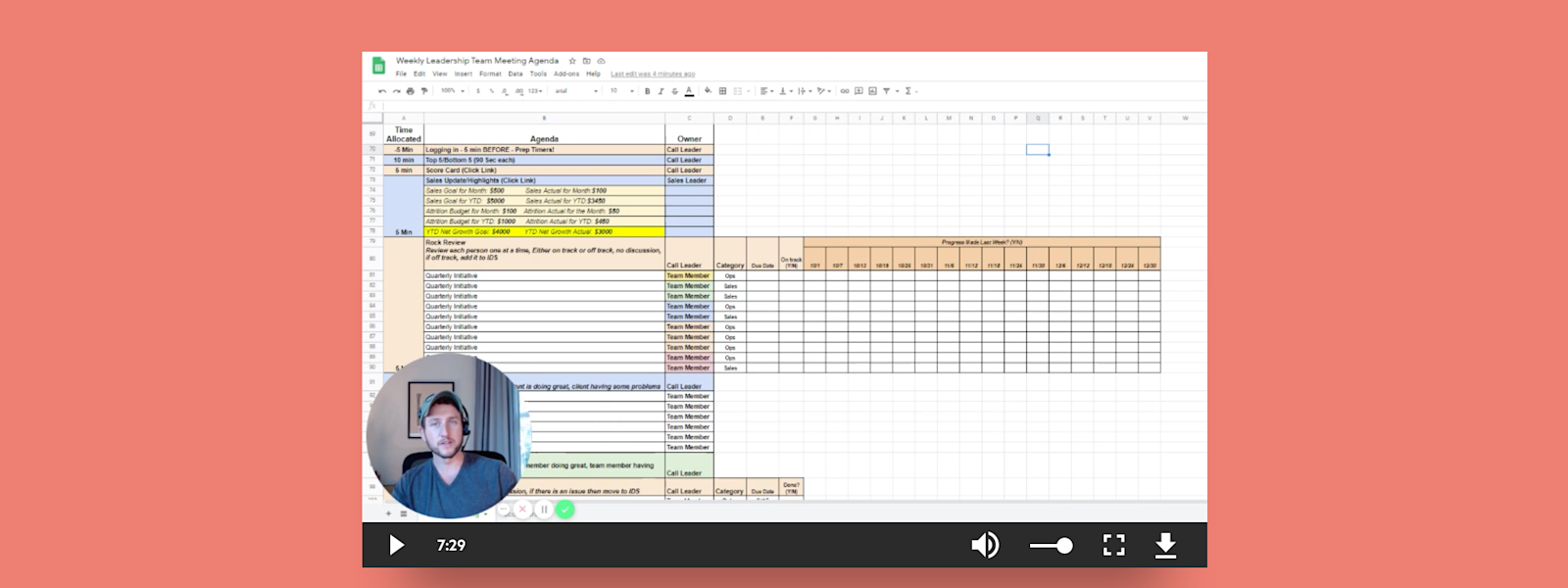How System Six Bookkeeping manage leadership team meetings with Karbon

Joe Carufe
Project Manager, Karbon
So often, meetings can seem like nothing more than necessary evils. Just something getting in the way and stopping you from actually getting work done. This can be especially true if you are a team leader in your accounting firm. You frequently feel like you do nothing but jump from meeting to meeting. And if the scheduled ones aren’t bad enough, there are always last-minute ones that pop up as well.

For the past 18 months at System Six, we have been using a meeting cadence that has alleviated most of these pitfalls. We are Karbon users, and this leadership team meeting method leverages Karbon, to help us get alignment around the highest priority tasks that our practice should be focused on.
Now I want to share it with you. This is our method for effective leadership meetings at System Six Bookkeeping. In this video, I explain how we use the agenda, and how that relates to our workflow and tasks in Karbon.
https://youtu.be/H7M4EcDGcUkThe meeting agenda that we use
We created a team meeting agenda that allows us to work through company updates and issues together, without detracting from the other things we are working on. It keeps us each accountable, and also avoids rabbit trails—working from the meeting agenda ultimately buys us more time.
This meeting agenda is mostly based on EOS (Entrepreneurial Operating System) and a book called Traction. We added a personal check-in sales scoreboard, client headlines, and team headlines but we give all the credit to the book and EOS model for helping us design this google sheet.
Our meeting structure
Meeting management
We use this agenda for our Monday leadership call. Attendees represent each department of System Six (Sales, Operations, Finance, Culture, Customer Service). One person is designated as the “call leader” and they are responsible for running the meeting and keeping everyone on track. If we don’t designate a leader, we can easily get lost in the weeds. The overarching goal is to bring everyone into the loop on what’s happening, where our progress stands, and what needs to happen next.
Maintain relationships
We always start with the relational connection. For us, this is the first ten minutes. We are a fully remote team, so this is particularly important for us. It allows us to connect on the highs and lows of life outside of work. It enables us to support one another during busy seasons and it also reminds us all that we are people, not just performers.
KPI reviews
Then we move into our scorecard section. This is five minutes of sales updates, landed contracts, goal statuses, leading and lagging indicators, and operational hiccups that led to lost revenue. Doing this each week gets us all on the same page about how our business is functioning in its quantitative elements. This section usually stirs some good conversation topics that we add to our IDS section below.
Know your “big rocks”
Next, we go into what we call our Rock Review. We check on our “big rocks”— this is what we call our large quarterly goals (see, rocks don’t have to weigh you down!). Each team leader is responsible for 1-3 “rocks” per quarter, and this meeting is a weekly opportunity to check-in, encourage, and help one another with our big-picture projects.
These “big rocks” require our primary focus and attention throughout the quarter so we check up on these weekly. Karbon is the tool that we use to track all of the underlying communication, sub-task assignments, and progress of the initiative. The leader’s job is to summarize all of that work from Karbon into a simple update. For example, “Yes, I’m on track to complete the initiative by the due date. And yes, my team and I made progress on it last week”
Headlines & accountability
We then spend a quick five minutes on “client headlines”, where we update one another on how clients are doing. Then, we do the same for our team. We move from there to our to-do list from the previous week, which is not only an accountability check but also a chance to address any roadblocks team members may be facing with their to-do items. These tasks are all managed in Karbon, and we assign them the week before.
Rather than needing to spend time throughout the week notifying each other of client or team headlines, we all know that this will be discussed in our standing weekly meeting. This minimizes our weekly distractions.
Identify, discuss, solve
Then it’s time for the main section of the meeting: IDS (Identify, Discuss, and Solve—once again, credit to Traction). We dedicate 45 minutes to bring up company issues and rank them by importance. Each team leader gets five votes and chooses which topics are the highest priority for them. The items with the most votes go to the top of the list, those with the least are bumped down to the bottom.
This ensures we are working on issues that are critical to the company as a whole, not to just one individual’s priorities. We get through as many elements as possible knowing that the rest will carry over to the next meeting. Out of this IDS time comes our to-do list for the following week. These tasks are added directly to the meeting agenda and also added to Karbon with the appropriate due date to ensure it doesn’t get lost.
Always improving
We finish with each team leader rating the meeting on a scale of 1-10. If there is a 7 or lower, the call leader gives that team leader an opportunity to explain their rating. It is a chance for us all to hear that and improve the meeting for next time.
Once the meeting is done the call leader copies the agenda, pastes below. Then they clear the solved issues, clear completed to-dos, moves to-do items from this week to last week, and ensure the agenda is prepared and “fresh” for the next week.
A clean slate! Something we’ll all be grateful for—especially the next week’s call leader. Throughout the week, leaders can add topics directly to the IDS section of this newly created agenda.
Know your meeting “why”
The main goal for this meeting, and the reason we stick to the agenda so closely, is communication and connection. We are able to stay in the loop with each other, with team members, with clients, and how we are tracking towards our overarching goals. This meeting reduces the need for daily calls and makes a huge difference in being able to better keep everyone’s respective time budget.
Having a predictable meeting template has been critical to our success. Not having clear guidelines for how a meeting will run or what should be included just leads to confusion, frustration, and miscommunication.
Don’t be afraid to get critical about how and why you meet! Hopefully, with some strategy, your business can find a cadence for your own leadership meetings that will motivate your team to reach its full potential.
Request your free copy of the System Six Leadership Meeting Agenda.
You can learn more about the processes we use at SystemSix on the SystemSix blog.
